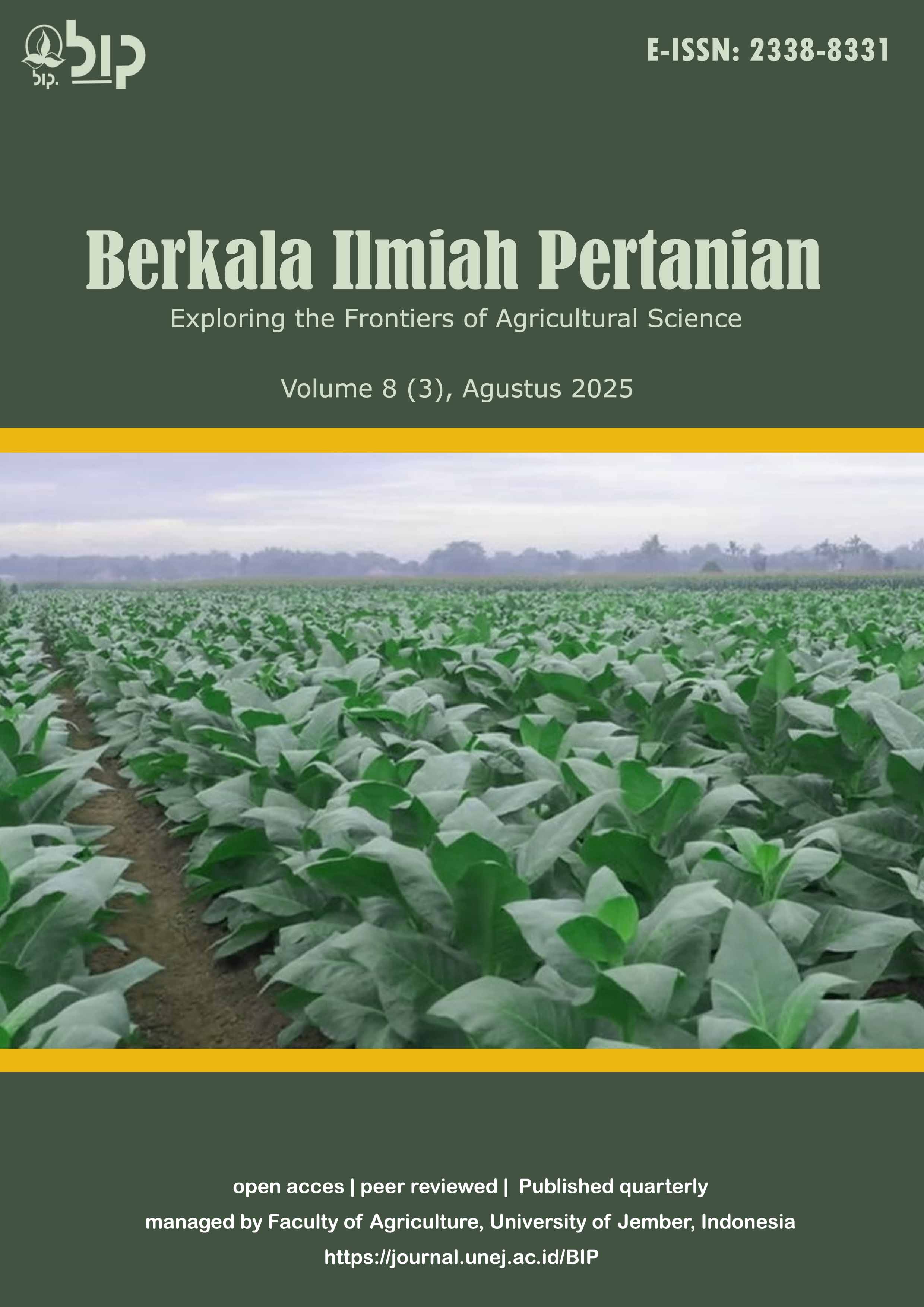Isolasi dan Karakterisasi Bakteri Toleran Logam Berat sebagai Agen Bioremediasi Merkuri (Hg) dan Timbal (Pb)
DOI:
https://doi.org/10.19184/bip.v8i3.53713Keywords:
bioremediation, tolerant bacteria, heavy metal, pathogenicity, hemolysisAbstract
Pencemaran logam berat, khususnya merkuri (Hg) dan timbal (Pb), telah menjadi masalah lingkungan yang serius akibat sifatnya yang persisten dan toksik. Penelitian ini bertujuan untuk mengisolasi dan mengkarakterisasi bakteri toleran logam berat dari tanah tercemar di area penambangan emas dan kawasan industri di Banten dan Bogor, serta mengevaluasi potensi patogenitasnya. Isolasi bakteri dilakukan menggunakan media Luria Bertani (LB) yang diperkaya dengan HgCl₂ dan PbCl₂, diikuti dengan karakterisasi morfologi dan uji patogenitas pada media blood agar. Hasil penelitian berhasil mengidentifikasi 27 isolat toleran Hg dan 30 isolat toleran Pb. Sebagian besar isolat menunjukkan karakteristik morfologi adaptif berupa koloni kecil, transparan, dan tidak berpigmen. Uji patogenitas mengungkapkan bahwa 55,56% isolat toleran Hg (15 isolat) dan 73,33% isolat toleran Pb (22 isolat) bersifat patogen (β-hemolisis), sedangkan 12 isolat toleran Hg dan 3 isolat toleran Pb tergolong non-patogen (γ-hemolisis). Temuan ini menunjukkan bahwa beberapa isolat memiliki potensi sebagai agen bioremediasi, aspek keamanan biologis perlu diperhatikan sebelum aplikasinya di lingkungan sebagai strategi bioremediasi logam berat secara aman dan berkelanjutan.
Downloads
References
Abd Elhady, M. A. E., Elsayed, A. I., Mohamed, S. H., Aboellil, A. H., & Ahmad, M. S. (2020). Isolation and Identification of Heavy Metal Tolerant Bacteria from Sugarcane Industrial Wastewater. Applied Ecology and Environmental Research, 18(1), 1387–1406. https://doi.org/10.15666/aeer/1801_13871406
Allam, A. A., El-shawadfy, A. M., Hassanein, W. A. E., Hamza, E. H. A., Morad, E. A., El Shafei, M. A. E., & El Etriby, D. E. (2020). Biochemical and immunological characterization of haemolysin produced by Pseudomonas aeruginosa PAO1 isolated from burn wounds. African Journal of Clinical and Experimental Microbiology, 21(2), 132–139. https://doi.org/10.4314/ajcem.v21i2.7
Amandita, F. Y., Efadeswarni, Ikhwani, A. Z. N., Idris, Sugiharto, A., Fatma, Y. S., Alfiansah, Y. R., & Sudiana, I. M. (2023). The growth of mercury-resistant bacterial consortium at different levels of pH, temperature, and C:N ratio. IOP Conference Series: Earth and Environmental Science, 1201(1), 012068. https://doi.org/10.1088/1755-1315/1201/1/012068
Brignoli, T., Douglas, E., Duggan, S., Fagunloye, O. G., Adhikari, R., Aman, M. J., & Massey, R. C. (2022). Wall Teichoic Acids Facilitate the Release of Toxins from the Surface of Staphylococcus aureus. Microbiology Spectrum, 10(4), e01011-22. https://doi.org/10.1128/spectrum.01011-22
Chasanah, U., Nuraini, Y., & Handayanto, E. (2018). The Potential of Mercury-Resistant Bacteria Isolated from Small-Scale Gold Mine Tailings for Accumulation of Mercury. Journal of Ecological Engineering, 19(2), 236–245. https://doi.org/10.12911/22998993/83565
Farahani, A. S., & Taghavi, S. M. (2017). Effects of bacterial populations, temperature and exogenous hydrogen peroxide on the induction of the hypersensitive response in Nicotiana tabacum against Xanthomonas perforans. Journal of Plant Protection Research, 57(2), 201–204. https://doi.org/10.1515/jppr-2017-0019
Firlandiana, M., Khairiyah, Y., Perala, I., Mustikaningrum, D., Kristiawan, K., Maimunah, M., Suprayitno, S., Prasetya, H., Dewi Setyana, A., & Subiyanto, S. (2024). Potensi Bakteri Pelarut Fosfat pada Lahan Tegakan Hutan dan Perkebunan Singkong di Kawasan Kampus IPB Dramaga Bogor. Produksi Tanaman, 12(7). https://doi.org/10.21776/ub.protan.2024.012.07.04
Ginting, R. C. B., Solihat, N., Hafsari, A. R., & Irawan. (2021). Potential bacteria capable of remediating mercury contaminated soils. IOP Conference Series: Earth and Environmental Science, 648(1), 012136. https://doi.org/10.1088/1755-1315/648/1/012136
Girisha, S. T. (2014). Lead Bioremediation with Respect to Mining and Industrial Effluents. International Research Journal of Environment Sciences, 3.
González Henao, S., & Ghneim-Herrera, T. (2021). Heavy Metals in Soils and the Remediation Potential of Bacteria Associated With the Plant Microbiome. Frontiers in Environmental Science, 9, 604216. https://doi.org/10.3389/fenvs.2021.604216
González-Reguero, D., Robas-Mora, M., Probanza Lobo, A., & Jiménez Gómez, P. A. (2023). Bioremediation of environments contaminated with mercury. Present and perspectives. World Journal of Microbiology and Biotechnology, 39(9), 249. https://doi.org/10.1007/s11274-023-03686-1
Hua, D. T., Lo, J., Do, H. Q., & Pham, C. D. (2022). A case of Citrobacter koseri renal abscess and review of the literature. SAGE Open Medical Case Reports, 10, 2050313X221135347. https://doi.org/10.1177/2050313X221135347
Hui, C., Ma, B., Wang, Y., Yang, X., & Cai, J. (2023). Designed bacteria based on natural pbr operons for detecting and detoxifying environmental lead: A mini-review. Ecotoxicology and Environmental Safety, 267, 115662. https://doi.org/10.1016/j.ecoenv.2023.115662
Iftita, W. D., Shovitri, M., & Zulaika, E. (2014). Pengaruh HgCl2 terhadap Viabilitas Bacillus S1 dan Potensi Enzim Pendegradasi Senyawa Organik. 3.
Islam, Md. M., Das, P., Islam, Md. M., Ahmed, S. R., Hossain, Md. L., Kabir, M. H., & Mamun, A. N. K. (2020). Heavy Metal Tolerant Bacteria Isolated and Detected From The Effluent Of Hazaribagh Tannery Industry In Dhaka City. Bacterial Empire, 3(3), 14–19. https://doi.org/10.36547/be.2020.3.3.14-19
Jarosławiecka, A., & Piotrowska-Seget, Z. (2014). Lead resistance in micro-organisms. Microbiology, 160(1), 12–25. https://doi.org/10.1099/mic.0.070284-0
Kapahi, M., & Sachdeva, S. (2019). Bioremediation Options for Heavy Metal Pollution. Journal of Health and Pollution, 9(24), 191203. https://doi.org/10.5696/2156-9614-9.24.191203
Karnwal, A., Martolia, S., Dohroo, A., Al-Tawaha, A. R. M. S., & Malik, T. (2024). Exploring bioremediation strategies for heavy metals and POPs pollution: The role of microbes, plants, and nanotechnology. Frontiers in Environmental Science, 12, 1397850. https://doi.org/10.3389/fenvs.2024.1397850
Kondakindi, V. R., Pabbati, R., Erukulla, P., Maddela, N. R., & Prasad, R. (2024). Bioremediation of heavy metals-contaminated sites by microbial extracellular polymeric substances – A critical view. Environmental Chemistry and Ecotoxicology, 6, 408–421. https://doi.org/10.1016/j.enceco.2024.05.002
Kowalczyk, A., Wilińska, M., Chyc, M., Bojko, M., & Latowski, D. (2016). Isolation, screening and identification of mercury resistant bacteria from mercury contaminated soil. E3S Web of Conferences, 10, 00042. https://doi.org/10.1051/e3sconf/20161000042
Kruti, M., Ishali, A., & Sanjay, P. (2024). Study of Multiple Metal Resistant Citrobacter sp. Isolated from Industrial Effluent. International Journal for Multidisciplinary Research.
Li, X., Liu, X., Bao, H., Wu, T., Zhao, Y., Liu, D., Li, X., Yang, T., & Yu, H. (2018). A Novel High Biosorbent of Pb-resistant Bacterium Isolate for the Removal of Hazardous Lead from Alkaline Soil and Water: Biosorption Isotherms In Vivo and Bioremediation Strategy. Geomicrobiology Journal, 35(3), 174–185. https://doi.org/10.1080/01490451.2017.1348405
López-Casaperalta, P., Febres-Molina, C., Aguilar-Pineda, J. A., Bernabe-Ortiz, J. C., & Fernandez-F, F. (2022). Peruvian Native Bacterial Strains as Potential Bioremediation Agents in Hg-Polluted Soils by Artisanal Mining Activities in Southern Peru. Sustainability, 14(16), 10272. https://doi.org/10.3390/su141610272
Maiti, A. (2013). Isolation and Characterization of Mercury Resistant Bacteria from Haldia river sediments. IOSR Journal Of Environmental Science, Toxicology And Food Technology, 5(3), 23–28. https://doi.org/10.9790/2402-0532328
McDevitt, E., Khan, F., Scasny, A., Eichembaun, Z., McDaniel, L. S., & Vidal, J. E. (2020). Hydrogen peroxide production by Streptococcus pneumoniae results in alpha-hemolysis by oxidation of oxy-hemoglobin to met-hemoglobin. https://doi.org/10.1101/2020.07.23.218966
Mensah, A. K., Sekyi-Annan, E., & Amoakwah, E. (2025). Availability and mobilisation of potentially harmful elements in contaminated mining sites: A systematic review of using soil amendments and plants for remediation. Journal of Trace Elements and Minerals, 12, 100234. https://doi.org/10.1016/j.jtemin.2025.100234
Mohite, B. V., Koli, S. H., Narkhede, C. P., Patil, S. N., & Patil, S. V. (2017). Prospective of Microbial Exopolysaccharide for Heavy Metal Exclusion. Applied Biochemistry and Biotechnology, 183(2), 582–600. https://doi.org/10.1007/s12010-017-2591-4
Nong, Q., Yuan, K., Li, Z., Chen, P., Huang, Y., Hu, L., Jiang, J., Luan, T., & Chen, B. (2019). Bacterial resistance to lead: Chemical basis and environmental relevance. Journal of Environmental Sciences, 85, 46–55. https://doi.org/10.1016/j.jes.2019.04.022
Nurfitriani, S., Arisoesilaningsih, E., Nuraini, Y., & Handayanto, E. (2020). Bioaccumulation of Mercury by Bacteria Isolated from Small Scale Gold Mining Tailings in Lombok, Indonesia. Journal of Ecological Engineering, 21(6), 127–136. https://doi.org/10.12911/22998993/123247
Pal, P., Pramanik, K., Ghosh, S. K., Mondal, S., Mondal, T., Soren, T., & Maiti, T. K. (2024). Molecular and eco-physiological responses of soil-borne lead (Pb2+)-resistant bacteria for bioremediation and plant growth promotion under lead stress. Microbiological Research, 287, 127831. https://doi.org/10.1016/j.micres.2024.127831
Pande, V., Pandey, S. C., Sati, D., Bhatt, P., & Samant, M. (2022). Microbial Interventions in Bioremediation of Heavy Metal Contaminants in Agroecosystem. Frontiers in Microbiology, 13, 824084. https://doi.org/10.3389/fmicb.2022.824084
Pepi, M., Focardi, S., Tarabelli, A., Volterrani, M., & Focardi, S. E. (2013). Bacterial strains resistant to inorganic and organic forms of mercury isolated from polluted sediments of the Orbetello Lagoon, Italy, and their possible use in bioremediation processes. E3S Web of Conferences, 1, 31002. https://doi.org/10.1051/e3sconf/20130131002
Pertiwi, B. L. S., Ustiatik, R., & Nuraini, Y. (2024). Lead (Pb)-Resistant Bacteria Improve Brassica chinensis Biomass and Reduce Pb Concentration in Pb-Contaminated Soil. Journal of Tropical Biodiversity and Biotechnology, 9(1), 86174. https://doi.org/10.22146/jtbb.86174
Prasanna, V., Rana, R., Daunaria, D. K., & Patel, N. B. (2022). Bacteremia due to carbapenem-resistant Citrobacter braakii. Journal of Family Medicine and Primary Care, 11(6), 3395–3395. https://doi.org/10.4103/jfmpc.jfmpc_1685_21
Qiu, C., & Hu, Z. (2007). The effects of Pb2+ stress on Chlorococcum sp. Journal of Wuhan University of Technology.
Rastija, D., Zebec, V., & Rastija, M. (2014). Impacts of Liming with Dolomite on Soil pH and Phosphorus and Potassium Availabilities. Növénytermelés. https://doi.org/10.12666/Novenyterm.63.2014.Suppl
Rocha, G. T., Montalvão, S. C. L., Queiroz, P. R. M., Berçot, M. R., Gomes, A. C. M. M., & Monnerat, R. G. (2023). Morphological and biochemical characterization of bacterial species of Bacillus, Lysinibacillus and Brevibacillus. Revista Ceres, 70(3), 91–104. https://doi.org/10.1590/0034-737x202370030010
Sánchez-Castro, I., Molina, L., Prieto-Fernández, M.-Á., & Segura, A. (2023). Past, present and future trends in the remediation of heavy-metal contaminated soil—Remediation techniques applied in real soil-contamination events. Heliyon, 9(6), e16692. https://doi.org/10.1016/j.heliyon.2023.e16692
Sapale, G., Patil, S. B., Raorane, C. J., & Sawant, N. (2015). Isolation and characterization of lead metal resistant bacteria for its prospects in bioremediation of contaminated soil. International Journal of Scientific Research, 2277.
Sezonov, G., Joseleau-Petit, D., & D’Ari, R. (2007). Escherichia coli Physiology in Luria Bertani Broth. Journal of Bacteriology, 189(23), 8746–8749. https://doi.org/10.1128/JB.01368-07
Shoaib, M., Muzammil, I., Hammad, M., Bhutta, Z. A., & Yaseen, I. (2020). A Mini-Review on Commonly used Biochemical Tests for Identification of Bacteria. International Journal of Research Publications, 54(1). https://doi.org/10.47119/IJRP100541620201224
Sohail, M., Rafiq, A., Naeem, M., Shahid, A., Ur Rehman, H., Usama Saeed, M., & Izhar, M. (2021). Effects of Different Types of Microbes on Blood Cells, Current Perspectives and Future Directions. Saudi Journal of Medical and Pharmaceutical Sciences, 7(1), 1–6. https://doi.org/10.36348/sjmps.2021.v07i01.001
Toledo-Hernández, E., Santana-Flores, A., Sánchez-Ayala, A., Romero-Ramírez, Y., Ortega-Acosta, S. Á., & Toribio-Jiménez, J. (2020). Aislamiento e identificación de bacterias tolerantes y bioacumuladoras de metales pesados, obtenidas de los jales mineros El Fraile, México. REVISTA TERRA LATINOAMERICANA, 38(1), 67. https://doi.org/10.28940/terra.v38i1.430
Vashishth, A., Tehri, N., & Kumar, P. (2019). The potential of naturally occurring bacteria for the bioremediation of toxic metals pollution. Brazilian Journal of Biological Sciences, 6(12), e366. https://doi.org/10.21472/bjbs.061205
Yang, Q., Wang, Y., & Zhong, H. (2021). Remediation of mercury-contaminated soils and sediments using biochar: A critical review. Biochar, 3(1), 23–35. https://doi.org/10.1007/s42773-021-00087-1
Yao, H., Wang, H., Ji, J., Tan, A., Song, Y., & Chen, Z. (2023). Isolation and Identification of Mercury-Tolerant Bacteria LBA119 from Molybdenum-Lead Mining Soils and Their Removal of Hg2+. Toxics, 11(3), 261. https://doi.org/10.3390/toxics11030261
Downloads
Published
Issue
Section
License
Copyright (c) 2025 Berkala Ilmiah Pertanian

This work is licensed under a Creative Commons Attribution-NonCommercial 4.0 International License.
Authors who publish with this journal agree to the following terms:
1.Authors retain copyright and grant the journal right of first publication with the work simultaneously licensed under a Creative Commons Attribution-NonCommercial 4.0 International License that allows others to share the work with an acknowledgement of the work's authorship and initial publication in this journal.
2.Authors are able to enter into separate, additional contractual arrangements for the non-exclusive distribution of the journal's published version of the work (e.g., post it to an institutional repository or publish it in a book), with an acknowledgement of its initial publication in this journal.
3.Authors are permitted and encouraged to post their work online (e.g., in institutional repositories or on their website) prior to and during the submission process, as it can lead to productive exchanges, as well as earlier and greater citation of published work (See The Effect of Open Access).




















